Often on household plots you can find unusual plants, which include ornamental cabbage. It is unpretentious, but pleases gardeners with various forms and colors to the very frosts.
Material Content:
Varieties and hybrids of decorative cabbage
Cabbage grows for 2 years. In the first year of her life, she releases rosettes from leaves of various shapes, and for 2 years she gives peduncles with seeds. It is appreciated for the variety of shades and shapes of leaves, popular in creating flower beds and flower borders.
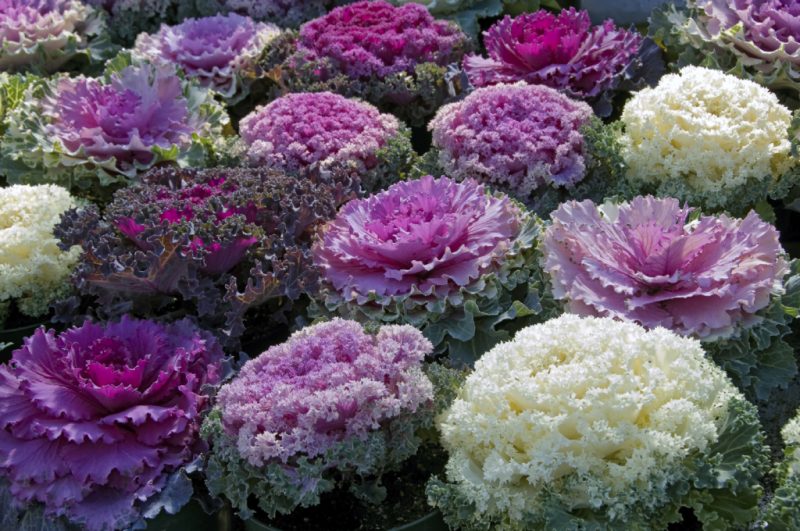
For the first time, exotic species and varieties of decorative cabbage were brought by Japanese breeders.
The most beautiful and popular varieties are:
- Sunset This species during flowering releases a stem on which there are several rosettes resembling roses. Cabbage is gaining its color and decorativeness in September, after autumn frosts.
- Piglon. The stem has light cream roses in the form of roses with corrugated leaves. This species is suitable for flower beds, as well as for planting in vases.
- Tokyo The variety has leaves of different shades wavy along the edge, collected in a rosette. From light pink to bright red. In height reaches up to 35 cm.
- Osaka The variety is distinguished by highly corrugated leaves, a diameter of the outlet up to 50 s and a height of up to 70 cm.
- Princess. Variety up to 50 cm tall has small carved and wavy leaves, the rosette is on a strong stem. It can be yellow, cream or red.
- Tongue Lark. The hybrid is tall, more than a meter high. Has long ribbed and curved leaves of green and purple up to 80 cm long.
All varieties and varieties of ornamental cabbage can easily tolerate frost and transplant.In autumn, they will decorate the flower garden and flowerbed with their bizarre colors and shapes. The plus is unpretentiousness in leaving.
The nuances of growing an unusual flower

Ornamental cabbage is an unpretentious plant, but nevertheless, it has special nuances of growing in the garden:
- In the first year after planting, the plant gains strength and forms foliage, and in the second year it blooms and gives seeds.
- It can reach a height of up to 1.5 meters and a diameter of 1 meter. All varieties differ in the shape and color of the leaves.
- A plant loves light. If it grows in the shade, then it changes its color.
- Cabbage seedlings can withstand severe frosts.
- It grows well in large flowerpots and containers.
- In a cut, it retains its qualities and appearance for a month.
- It is grown in seedlings, seedlings appear after 3-4 days.
If you take into account all the nuances and subtleties of growing an unusual flower, it will delight you with a long vegetation period, various colors and curly leaves.
How to grow seedlings at home
Ornamental cabbage is grown using seeds. Sowing must begin in March or early April. To do this, prepare boxes with fertile and loose soil. The main condition for the success of rooting is the optimal temperature regime. The first 2 weeks it is important to observe a temperature of 7-12 degrees. Next, you should increase it to 15 degrees.
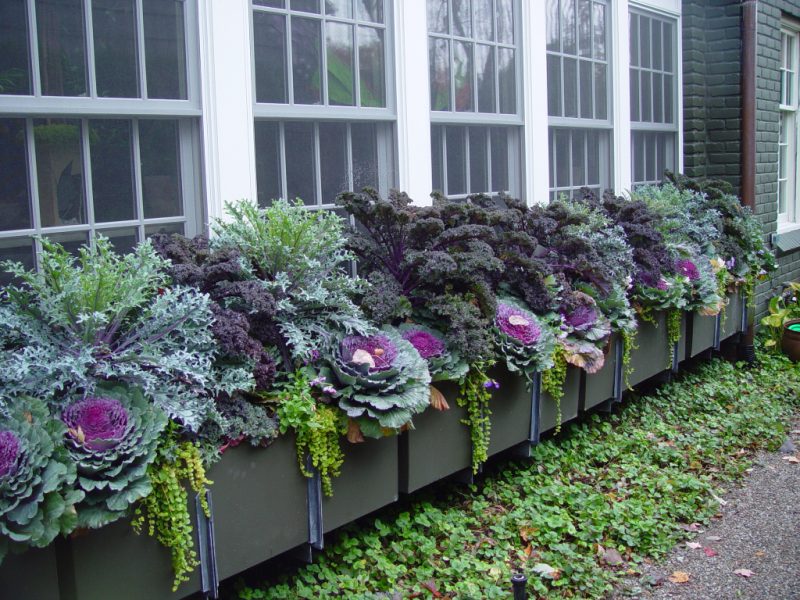
Before planting, it is necessary to prepare nutritious soil.
It can be mixed independently from:
- turf land;
- sheet land;
- peat;
- and humus.
After preparing the boxes with the ground, it is necessary to make grooves in it, adhering to a distance of 2 cm between them. The grooves must first be shed with settled water, and then the seeds must be laid in them. Sprinkle 1 cm of soil on top, moisten the soil with a spray bottle and cover with glass or a bag. After 3-5 days, the first shoots should appear, then the glass or film must be removed.
Important! Do not abuse seedling watering so that rot does not form on the seedlings. Sprouts need to be sprayed as the earth dries in the drawers.
After 2-3 real leaflets appear on the seedlings, seedlings must be dived into separate peat pots. You need to plant cabbage in open ground together with an earthen lump so that fragile roots are not damaged.
Planting rules: how and when?
Planting of young seedlings in open ground begins in late April - early May, when there are 6 leaflets on the seedlings. You can plant the seeds immediately in open ground on a prepared bed.
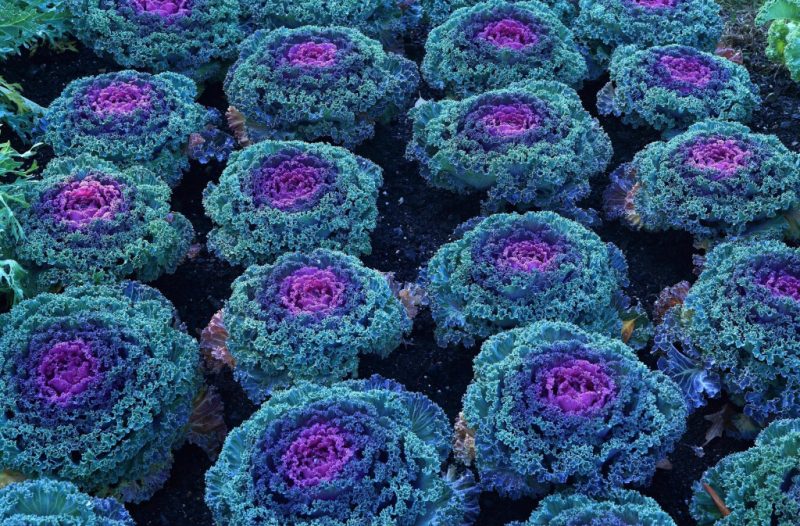
To do this, in April you need:
- dig in the necessary area and add humus to it;
- plant seedlings on prepared beds, keeping a distance of half a meter between the bushes;
- pre-seedlings need to be moistened so that they are easier to "get out" of the pots;
- seedlings in peat glasses are placed in the soil with them, it is better if the plant is replanted with a lump of earth;
- soil and seedlings around seedlings.
Spring is an insidious time, so it’s important to cover the crops from night to night with covering material. And on warm sunny days, shelter should be removed for ventilation.
When all the basic rules are followed, the seedlings will be perfectly accepted in a new place.
Garden care
Although an unusual flower is an unpretentious plant, it is nevertheless necessary to produce timely care for it.
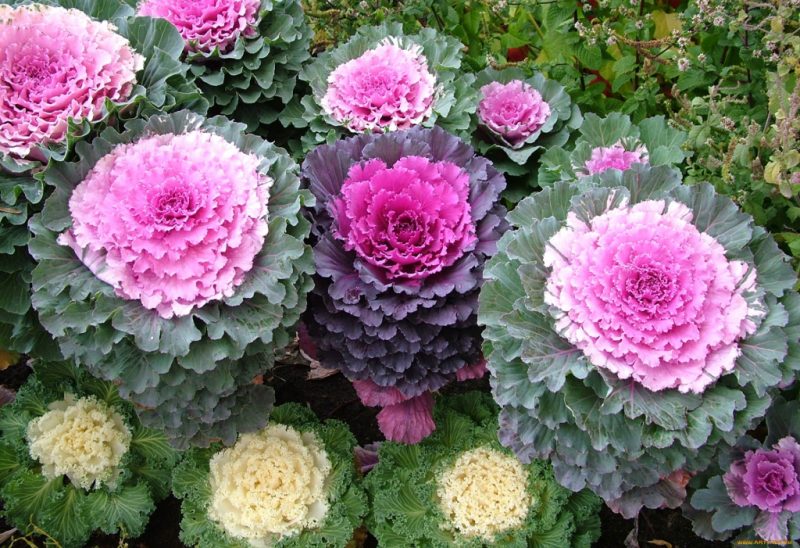
Care for cabbage is as follows:
- Watering and irrigation should be carried out in hot weather daily, and on other days, as the topsoil dries.
- To retain moisture, you can mulch the plant with grass, sawdust.
- Regularly you need to remove weeds and loosen the soil near the bush.
- In the summer months, during active growth, it is necessary to fertilize with liquid fertilizers or mullein. The frequency of fertilizer should be 1-2 times a month.
- Apply preventive and pest and disease control measures.
With timely and proper care of cabbage, it will bloom until the frost. In autumn, it can be dug up and planted in a flowerpot - the plant perfectly survives in room conditions.
Diseases, pests and methods of dealing with them
Like all plants, ornamental cabbage can be attacked by pests. The main thing is to recognize harmful insects in time and take measures to combat them.
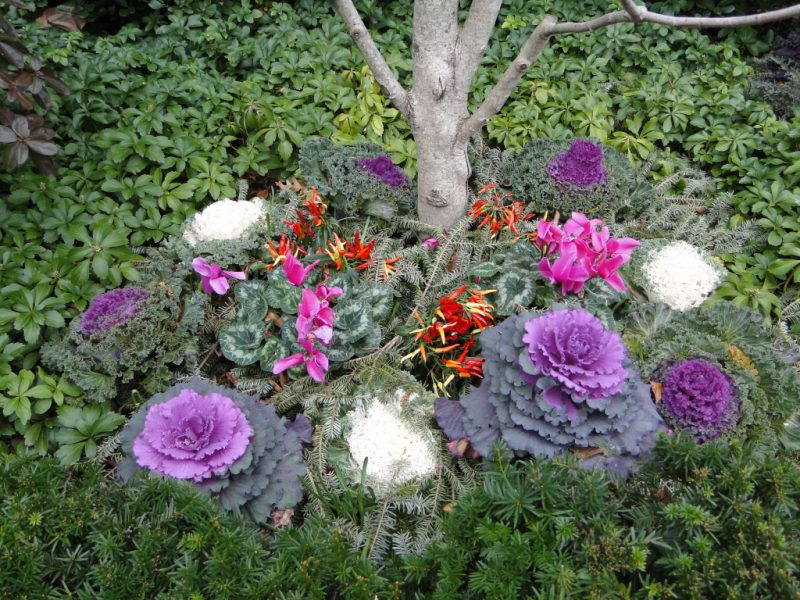
The main cabbage enemies are:
- Cruciferous fleas. They crawl out of the soil in early spring and eat the leaves of the plant. Young weakened seedlings can die from such pests. To fight them yourself, you need to process the bush with wood ash.
- Slug. If these parasites are found, it is necessary to inspect the bush, collect them with your hands and treat the plant with fungicides.
- Caterpillars. They are also fatal to young landings. In the fight against them, it is necessary to collect visible individuals, destroy, and treat the plant with a chemical solution.
- Cabbage whitewash. Marigold garden flowers will help to scare away butterflies. They are planted between the cabbage rows so that they scare away insects with their specific aroma.
Decorative cabbage in landscaping
This plant is often used in landscaping. Several types of cabbage are often combined to create vibrant compositions. Tall varieties are selected in the center of the flower beds, and Japanese decorative cabbage is suitable at the edges.
It is stunted, reaches a height of up to 30 cm, and therefore it is used for:
- registration of a lawn together with perennial flowers;
- registration of flower beds in the adjacent areas:
- registration of borders in parks and on playgrounds;
- creating various ornaments of different colors.
An ornamental plant can not only decorate personal plots, but is also useful for eating both fresh and pickled. Growing a unique flower will not be difficult even for inexperienced gardeners, the main thing is to give him a little time and care.















